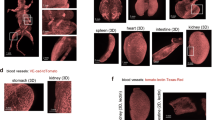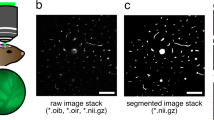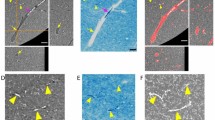Abstract
Tissue clearing methods enable the imaging of biological specimens without sectioning. However, reliable and scalable analysis of large imaging datasets in three dimensions remains a challenge. Here we developed a deep learning-based framework to quantify and analyze brain vasculature, named Vessel Segmentation & Analysis Pipeline (VesSAP). Our pipeline uses a convolutional neural network (CNN) with a transfer learning approach for segmentation and achieves human-level accuracy. By using VesSAP, we analyzed the vascular features of whole C57BL/6J, CD1 and BALB/c mouse brains at the micrometer scale after registering them to the Allen mouse brain atlas. We report evidence of secondary intracranial collateral vascularization in CD1 mice and find reduced vascularization of the brainstem in comparison to the cerebrum. Thus, VesSAP enables unbiased and scalable quantifications of the angioarchitecture of cleared mouse brains and yields biological insights into the vascular function of the brain.
This is a preview of subscription content, access via your institution
Access options
Access Nature and 54 other Nature Portfolio journals
Get Nature+, our best-value online-access subscription
$29.99 / 30 days
cancel any time
Subscribe to this journal
Receive 12 print issues and online access
$259.00 per year
only $21.58 per issue
Buy this article
- Purchase on Springer Link
- Instant access to full article PDF
Prices may be subject to local taxes which are calculated during checkout






Similar content being viewed by others
Data availability
VesSAP data are publicly hosted at http://DISCOtechnologies.org/VesSAP and include original scans and registered atlas data.
Code availability
VesSAP codes are publicly hosted at http://DISCOtechnologies.org/VesSAP and include the imaging protocol, trained algorithms, training data and a reference set of features describing the vascular network in all brain regions. Additionally, the source code is hosted on GitHub (https://github.com/vessap/vessap) and on the executable platform Code Ocean (https://doi.org/10.24433/CO.1402016.v1)52. Implementation of external libraries is available on request.
References
Bennett, R. E. et al. Tau induces blood vessel abnormalities and angiogenesis-related gene expression in P301L transgenic mice and human Alzheimer’s disease. Proc. Natl Acad. Sci. USA 115, E1289–E1298 (2018).
Obenaus, A. et al. Traumatic brain injury results in acute rarefication of the vascular network. Sci. Rep. 7, 239 (2017).
Völgyi, K. et al. Chronic cerebral hypoperfusion induced synaptic proteome changes in the rat cerebral cortex. Mol. Neurobiol. 55, 4253–4266 (2018).
Klohs, J. et al. Contrast-enhanced magnetic resonance microangiography reveals remodeling of the cerebral microvasculature in transgenic ArcAbeta mice. J. Neurosci. 32, 1705–1713 (2012).
Edwards-Richards, A. et al. Capillary rarefaction: an early marker of microvascular disease in young hemodialysis patients. Clin. Kidney J. 7, 569–574 (2014).
Calabrese, E., Badea, A., Cofer, G., Qi, Y. & Johnson, G. A. A diffusion MRI tractography connectome of the mouse brain and comparison with neuronal tracer data. Cereb. Cortex 25, 4628–4637 (2015).
Dyer, E. L. et al. Quantifying mesoscale neuroanatomy using X-ray microtomography. eNeuro 4, ENEURO.0195-17.2017 (2017).
Li, T., Liu, C. J. & Akkin, T. Contrast-enhanced serial optical coherence scanner with deep learning network reveals vasculature and white matter organization of mouse brain. Neurophotonics 6, 035004 (2019).
Tsai, P. S. et al. Correlations of neuronal and microvascular densities in murine cortex revealed by direct counting and colocalization of nuclei and vessels. J. Neurosci. 29, 14553–14570 (2009).
Lugo-Hernandez, E. et al. 3D visualization and quantification of microvessels in the whole ischemic mouse brain using solvent-based clearing and light sheet microscopy. J. Cereb. Blood Flow Metab. 37, 3355–3367 (2017).
Frangi, A. F., Niessen, W. J., Vincken, K. L. & Viergever, M. A. in International Conference on Medical Image Computing and Computer-Assisted Intervention 130–137 (Springer, 1998).
Sato, Y. et al. Three-dimensional multi-scale line filter for segmentation and visualization of curvilinear structures in medical images. Med. Image Anal. 2, 143–168 (1998).
Di Giovanna, A. P. et al. Whole-brain vasculature reconstruction at the single capillary level. Sci. Rep. 8, 12573 (2018).
Xiong, B. et al. Precise cerebral vascular atlas in stereotaxic coordinates of whole mouse brain. Front. Neuroanat. 11, 128 (2017).
Clark, T. A. et al. Artery targeted photothrombosis widens the vascular penumbra, instigates peri-infarct neovascularization and models forelimb impairments. Sci. Rep. 9, 2323 (2019).
Yao, J., Maslov, K., Hu, S. & Wang, L. V. Evans blue dye—enhanced capillary-resolution photoacoustic microscopy in vivo. J. Biomed. Opt. 14, 054049 (2009).
Ertürk, A. et al. Three-dimensional imaging of solvent-cleared organs using 3DISCO. Nat. Protoc. 7, 1983–1995 (2012).
Reitsma, S. et al. Endothelial glycocalyx structure in the intact carotid artery: a two-photon laser scanning microscopy study. J. Vasc. Res. 48, 297–306 (2011).
Schimmenti, L. A., Yan, H. C., Madri, J. A. & Albelda, S. M. Platelet endothelial cell adhesion molecule, PECAM‐1, modulates cell migration. J. Cell. Physiol. 153, 417–428 (1992).
Tetteh, G. et al. DeepVesselNet: vessel segmentation, centerline prediction, and bifurcation detection in 3-D angiographic volumes. Preprint at https://arxiv.org/abs/1803.09340 (2018).
Weigert, M. et al. Content-aware image restoration: pushing the limits of fluorescence microscopy. Nat. Methods 15, 1090–1097 (2018).
Wang, H. et al. Deep learning enables cross-modality super-resolution in fluorescence microscopy. Nat. Methods 16, 103–110 (2019).
Falk, T. et al. U-Net: deep learning for cell counting, detection, and morphometry. Nat. Methods 16, 67–70 (2019).
Caicedo, J. C. et al. Data-analysis strategies for image-based cell profiling. Nat. Methods 14, 849–863 (2017).
Dorkenwald, S. et al. Automated synaptic connectivity inference for volume electron microscopy. Nat. Methods 14, 435–442 (2017).
Liu, S., Zhang, D., Song, Y., Peng, H. & Cai, W. in Machine Learning in Medical Imaging (eds., Wang, Q. et al.) 185–193 (Springer International Publishing, 2017).
Long, J., Shelhamer, E. & Darrell, T. Fully convolutional networks for semantic segmentation. in Proceedings of the IEEE Conference on Computer Vision and Pattern Recognition 3431–3440 (IEEE, 2015).
Livne, M. et al. A U-Net deep learning framework for high performance vessel segmentation in patients with cerebrovascular disease. Front. Neurosci. 13, 97 (2019).
Çiçek, Ö., Abdulkadir, A., Lienkamp, S. S., Brox, T. & Ronneberger, O. 3D U-Net: learning dense volumetric segmentation from sparse annotation. in Medical Image Computing and Computer-Assisted Intervention 424–432 (2016).
Milletari, F., Navab, N. & Ahmadi, S.A. V-Net: fully convolutional neural networks for volumetric medical image segmentation. in 2016 Fourth International Conference on 3D Vision 565–571 (IEEE, 2016).
Litjens, G. et al. A survey on deep learning in medical image analysis. Med. Image Anal. 42, 60–88 (2017).
Schneider, M., Reichold, J., Weber, B., Szekely, G. & Hirsch, S. Tissue metabolism driven arterial tree generation. Med. Image Anal. 16, 1397–1414 (2012).
Chalothorn, D., Clayton, J. A., Zhang, H., Pomp, D. & Faber, J. E. Collateral density, remodeling, and VEGF-A expression differ widely between mouse strains. Physiol. Genomics 30, 179–191 (2007).
Li, S. Z. In Computer Vision—ECCV (ed., Eklundh, J.-O.) 361–370 (Springer, 1994).
Pan, C. et al. Shrinkage-mediated imaging of entire organs and organisms using uDISCO. Nat. Methods 13, 859–867 (2016).
Cai, R. et al. Panoptic imaging of transparent mice reveals whole-body neuronal projections and skull–meninges connections. Nat. Neurosci. 22, 317–327 (2019).
Menti, E., Bonaldi, L., Ballerini, L., Ruggeri, A. & Trucco, E. In International Workshop on Simulation and Synthesis in Medical Imaging 167–176 (Springer, Year).
Kataoka, H. et al. Fluorescent imaging of endothelial glycocalyx layer with wheat germ agglutinin using intravital microscopy. Microsc. Res. Tech. 79, 31–37 (2016).
Steinwall, O. & Klatzo, I. Selective vulnerability of the blood–brain barrier in chemically induced lesions. J. Neuropathol. Exp. Neurol. 25, 542–559 (1966).
Zhang, H., Prabhakar, P., Sealock, R. & Faber, J. E. Wide genetic variation in the native pial collateral circulation is a major determinant of variation in severity of stroke. J. Cereb. Blood Flow Metab. 30, 923–934 (2010).
Breckwoldt, M. O. et al. Correlated magnetic resonance imaging and ultramicroscopy (MR-UM) is a tool kit to assess the dynamics of glioma angiogenesis. eLife 5, e11712 (2016).
Kingma, D. P. & Ba, J. Adam: a method for stochastic optimization. Preprint at https://arxiv.org/abs/1412.6980 (2017).
Abadi, M. et al. in 12th USENIX Symposium on Operating Systems Design and Implementation 265–283 (2016).
Hoo-Chang, S. et al. Deep convolutional neural networks for computer-aided detection: CNN architectures, dataset characteristics and transfer learning. IEEE Trans. Med. Imaging 35, 1285–1298 (2016).
Schneider, M., Hirsch, S., Weber, B., Székely, G. & Menze, B. H. Joint 3-D vessel segmentation and centerline extraction using oblique Hough forests with steerable filters. Med. Image Anal. 19, 220–249 (2015).
Paetzold, J. C. et al. clDice—a novel connectivity-preserving loss function for vessel segmentation. in Medical Imaging Meets NeurIPS 2019 Workshop (2019).
Lee, T. C., Kashyap, R. L. & Chu, C. N. Building skeleton models via 3-D medial surface axis thinning algorithms. Graph. Models Image Process. 56, 462–478 (1994).
Rempfler, M. et al. Reconstructing cerebrovascular networks under local physiological constraints by integer programming. Med. Image Anal. 25, 86–94 (2015).
Marchesi, V. T. Alzheimer’s dementia begins as a disease of small blood vessels, damaged by oxidative-induced inflammation and dysregulated amyloid metabolism: implications for early detection and therapy. FASEB J. 25, 5–13 (2011).
Klein, S., Staring, M., Murphy, K., Viergever, M. A. & Pluim, J. P. Elastix: a toolbox for intensity-based medical image registration. IEEE Trans. Med. Imaging 29, 196–205 (2009).
Cohen, J. The effect size index: d. Stat. Power Anal. Behav. Sci. 2, 284–288 (1988).
Paetzold, J. C. & Tetteh, G. VesSAP: machine learning analysis of whole mouse brain vasculature. Code Ocean https://doi.org/10.24433/CO.1402016.v1 (2020).
Acknowledgements
This work was supported by the Vascular Dementia Research Foundation, Deutsche Forschungsgemeinschaft (DFG, German Research Foundation) under Germany’s Excellence Strategy within the framework of the Munich Cluster for Systems Neurology (EXC 2145 SyNergy, ID 390857198), ERA-Net Neuron (01EW1501A to A.E.), Fritz Thyssen Stiftung (to A.E.; reference no. 10.17.1.019MN), a DFG research grant (to A.E.; reference no. ER 810/2-1), the Helmholtz ICEMED Alliance (to A.E.), the NIH (to A.E.; reference no. AG057575) and the German Federal Ministry of Education and Research via the Software Campus initiative (to O.S.). S.S. is supported by the Translational Brain Imaging Training Network (TRABIT) under the European Union’s Horizon 2020 research and innovation program (grant agreement ID 765148). Furthermore, NVIDIA supported this work via the GPU Grant Program. V.E. was funded by Human Brain Project (HBP SGA 2, 785907). M.I.T. is a member of the Graduate School of Systemic Neurosciences (GSN), Ludwig Maximilian University of Munich. We thank R. Cai, C. Pan, F. Voigt, I. Ezhov, A. Sekuboyina, M. Goergens, F. Hellal, R. Malik, U. Schillinger and T. Wang for technical advice and C. Heisen for critical reading of the manuscript.
Author information
Authors and Affiliations
Contributions
M.I.T. performed the tissue processing, clearing and imaging experiments. M.I.T. and K.T.-V. developed the whole-brain staining protocol. M.I.T. stitched and assembled the whole-brain scans. V.E. and J.C.P. generated the synthetic vascular training dataset. J.C.P., G.T. and O.S. developed the deep learning architecture and trained the models. J.C.P. and S.S. performed the quantitative analyses. M.I.T. annotated the data. M. Düring and M. Dichgans helped with data interpretation. B.M., M.P. and G.T. provided guidance in developing the deep learning architecture and helped with data interpretation. A.E., M.I.T., B.M. and J.C.P. wrote the manuscript. All authors edited the manuscript. A.E. initiated and led all aspects of the project.
Corresponding authors
Ethics declarations
Competing interests
The authors declare no competing interests.
Additional information
Peer review information Nina Vogt was the primary editor on this article and managed its editorial process and peer review in collaboration with the rest of the editorial team.
Publisher’s note Springer Nature remains neutral with regard to jurisdictional claims in published maps and institutional affiliations.
Integrated supplementary information
Supplementary Figure 1 Vasculature of a CD1 mouse, stained with WGA and EB.
a, Sagittal maximum intensity projections. b, Coronal maximum intensity projections. c, Axial maximum projections. d-f, Close-ups where capillary level staining is evident. The experiment was performed 9 times with similar results.
Supplementary Figure 2 Experimental measurement of the point spread function (PSF) of the LaVision light-sheet Ultramicroscope II.
a, Red fluorescent beads (diameter 0.1 µm) were embedded in 1% agarose gel and cleared using 3DISCO. The beads were then imaged in BABB medium (RI = 1.56) using 4× objective lens (Olympus XLFLUOR 340), at 580/25 nm excitation and with a 625/30 nm emission filter by sampling at 1.625 × 1.625 × 1 µm. b, Full width half maximum (FWHM) measure derived from the Gaussian fit to the intensity profile, along the indicated cross-sections in the center of the diffraction pattern (a) of an exemplary bead. c, Quantification of the PSF distribution (n = 6) derived from the Gaussian fittings. All data values are given as mean ± SEM.
Supplementary Figure 3 Validation of complimentary staining of the neurovasculature.
a,b, Maximum intensity projection of confocal microscopy imaging of WGA and EB signal respectively. c, Merging of the two signals. d-h, Maximum intensity projections of the light-sheet microscopy imaging of a representative C57BL/6J specimen stained with EB, showing the major vascular segments in different planes. The experiment was performed 3 times with similar results.
Supplementary Figure 4 Raw signal intensity distribution along line profiles across stained vessels for three animals.
Fluorescence signal profiles for WGA and EB plotted based on vessel size. Data are separated based on WGA and EB signal intensity: a) comparable WGA and EB signal intensity, b) Signal intensity is stronger for WGA than for EB, c) Signal intensity is stronger for EB than for WGA.
Supplementary Figure 5 Comparison of the signal strength of anti-CD31 and lectin dyes.
a-b, Axial maximum intensity projection of 150 µm thick tissue, stained as indicated. c, SNR quantifications on the line profiles indicated in (a) and (b) with warm and cold colored lines for small and large sized segments, respectively. The red arrowheads indicate where the signal of the vasculature gets higher. The experiments were performed on one mouse per condition.
Supplementary Figure 6 Demonstration of the synthetic data used for VesSAP.
3D visualization including radius information in pixels (px) for one exemplary volume of synthetic data, which was used for pre-training our model in our transfer learning approach.
Supplementary Figure 7 Details of the segmentation quality by VesSAP.
a, b, Side by side slices of the raw WGA channel image (a) and the segmentation (b). c, 3D rendering of a small brain volume. The experiment was performed on 9 different mice with similar results.
Supplementary Figure 8 Three spaces of reported features.
Visualization of the three distinct spaces, in which we report the extracted features. The steps to account for the Euclidean length and the tissue shrinkage are visualized with an exemplary calculation of the vessel length of three vessel pixels in a 2D plane.
Supplementary Figure 9 Regression analysis of the neurovasculature in mouse strains.
Scatter plot of the local vessel length against the local bifurcation density (Pearson’s r = 0.9657; p = 1.7 × 10-125). Each point represents the mean of three animals per strain.
Supplementary information
Supplementary Information
Supplementary Figs. 1–9 and Supplementary Tables 1–12
Supplementary Video 1
Visualization of WGA and EB double staining using confocal microscopy. Representative tissue visualization of WGA and EB double staining of the cerebrovasculature showing that vessels are not collapsed but retain their circular shape (for example, the white arrow along the vessel). WGA is shown in white, and EB is shown in magenta. The experiment was performed three times with similar results.
Supplementary Video 2
Visualization of WGA and EB double staining using light-sheet microscopy. Visualization of a representative CD1 mouse brain by VesSAP. The experiment was performed three times with similar results.
Supplementary Video 3
Virtual reality-optimized visualization of the cerebrovasculature of the intact brain in Vision4D. The whole mouse brain shown in Supplementary Video 2 has been rendered for virtual reality viewing by using Arivis InViewR. Please see http://DISCOtechnologies.org/VesSAP/#VR for further information on how to view this virtual reality video.
Supplementary Video 4
Detailed visualization of vascular segmentation and feature extraction from light-sheet data. Segmentation and features demonstration on a subset of the whole dataset. VesSAP enables reliable segmentation (red) and feature extraction (bifurcation points and centerlines in green and cyan, respectively) down to the capillary level from imaging data (gray). The experiment was performed on nine mice with similar results.
Supplementary Video 5
Overall visualization of registration of the segmentation to the Allen brain atlas in Imaris. Whole-brain data registered to the Allen adult brain atlas. The experiment was performed on nine mice with similar results.
Supplementary Video 6
Detailed visualization of the registration and segmentation in Vision4D. Substack of the whole-brain data registered to the Allen adult brain atlas. This video shows full-resolution segmentation on a small set of the brain scan data. The experiment was performed nine times with similar results.
Rights and permissions
About this article
Cite this article
Todorov, M.I., Paetzold, J.C., Schoppe, O. et al. Machine learning analysis of whole mouse brain vasculature. Nat Methods 17, 442–449 (2020). https://doi.org/10.1038/s41592-020-0792-1
Received:
Accepted:
Published:
Issue Date:
DOI: https://doi.org/10.1038/s41592-020-0792-1
This article is cited by
-
Current and future applications of light-sheet imaging for identifying molecular and developmental processes in autism spectrum disorders
Molecular Psychiatry (2024)
-
Noise learning of instruments for high-contrast, high-resolution and fast hyperspectral microscopy and nanoscopy
Nature Communications (2024)
-
Therapy-induced modulation of tumor vasculature and oxygenation in a murine glioblastoma model quantified by deep learning-based feature extraction
Scientific Reports (2024)
-
Vascularized organoid-on-a-chip: design, imaging, and analysis
Angiogenesis (2024)
-
Direct association with the vascular basement membrane is a frequent feature of myelinating oligodendrocytes in the neocortex
Fluids and Barriers of the CNS (2023)



